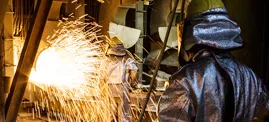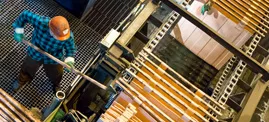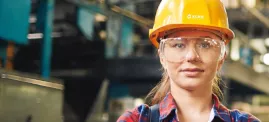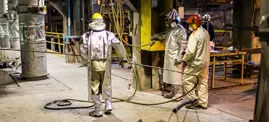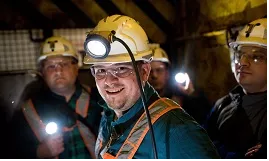General Information
The Cedynia copper wire rod plant, located in Orsk, in the Lower Silesia region of Poland, is a modern rolling mill that transforms electrolytically refined cathode copper from the Głogów and Legnica copper smelter/refineries as well as copper scrap into copper wire rod and the highest quality oxygen-free copper rod. These are the most highly processed copper products offered by KGHM, products that meet the demands of the most demanding customers. The Cedynia copper wire rod plant offers the following products:
- 8 mm copper wire rod for enamelled cables, thin and ultra-thin wires, wire bunches of up to Ø 0.1 mm and for telecommunications and power cables;
- 8 mm oxygen-free copper wire rod for the production, among others, of microwires up to 20 µ in diameter, enamelled cables, fire-resistant safety cables, and audio and visual cables.
History
The Cedynia copper wire rod plant began production on May 9, 1979 with the commissioning, based on the Belgian Contirod technology, of a modern continuous copper melting, casting, and rolling line with an annual production capacity of about 100,000 tonnes.
Between 1994 and 2004, with the growing demand of European markets for high-quality copper wire rod, the Cedynia plant’s production more than doubled and in 2007 it exceeded 250 thousand tonnes.
New products have been introduced. In 2006, a new installation for the production of oxygen-free copper wire, based on the Upcast technology, was put into operation, expanding the plant’s production capacity by 15,000 tonnes of copper per year.
In 2007, additional production of alloy wire with the addition of silver was started.
Since 2009, the Cedynia plant also produces wire rod and wire granules. In order to increase their production, a dedicated building was put into operation in 2019.
Production
The Cedynia plant makes its products using two processes: Contirod and Upcast.
The Contirod process is used to make fine-grained copper wire rod with evenly distributed oxygen. In the first phase of production, copper cathodes are melted in an Asarco furnace and the liquid copper goes to a settling furnace, from where it is dosed into a Hazelett casting machine where it crystallizes into a 60 x 122 mm band. It is then rolled into its final form, which is an 8 mm diameter wire rod, rolled into coils weighing 5 tonnes and protected from secondary oxidation by a layer of synthetic wax.
The Upcast process is used to make an oxygen-free copper wire in a structurally cast state, characterized by an even cross-section structure. Cu-OFE wire with a diameter of 8 to 25 mm is made using a process that includes cathode loading, a melting furnace, a settling furnace, a casting machine with crystallizers for vertical casting, and coiling machines.
The Upcast process also produces oxygen-free, silver-bearing copper wire in diameters from 8 to 25 mm, with silver contents of 100 ppm, 330 ppm, 400 ppm, 1,000 ppm, and 2,000 ppm.
Both the wire rod and the wire produced in the processes described above are used by the Cedynia plant to make 8 mm and 12.7 mm diameter granules, cut to lengths of 10-25 mm.
The Cedynia plant holds a certificate confirming that the Division operates on the basis of an Integrated Management System for the production of processed products in the form of wire rod, oxygen-free copper wire, and low-alloy copper wire, that meets the requirements specified in PN-EN ISO 9001:2015, PN-EN ISO 14001:2015, PN-EN ISO 45001:2018, and PN-EN ISO 50001:2018.

